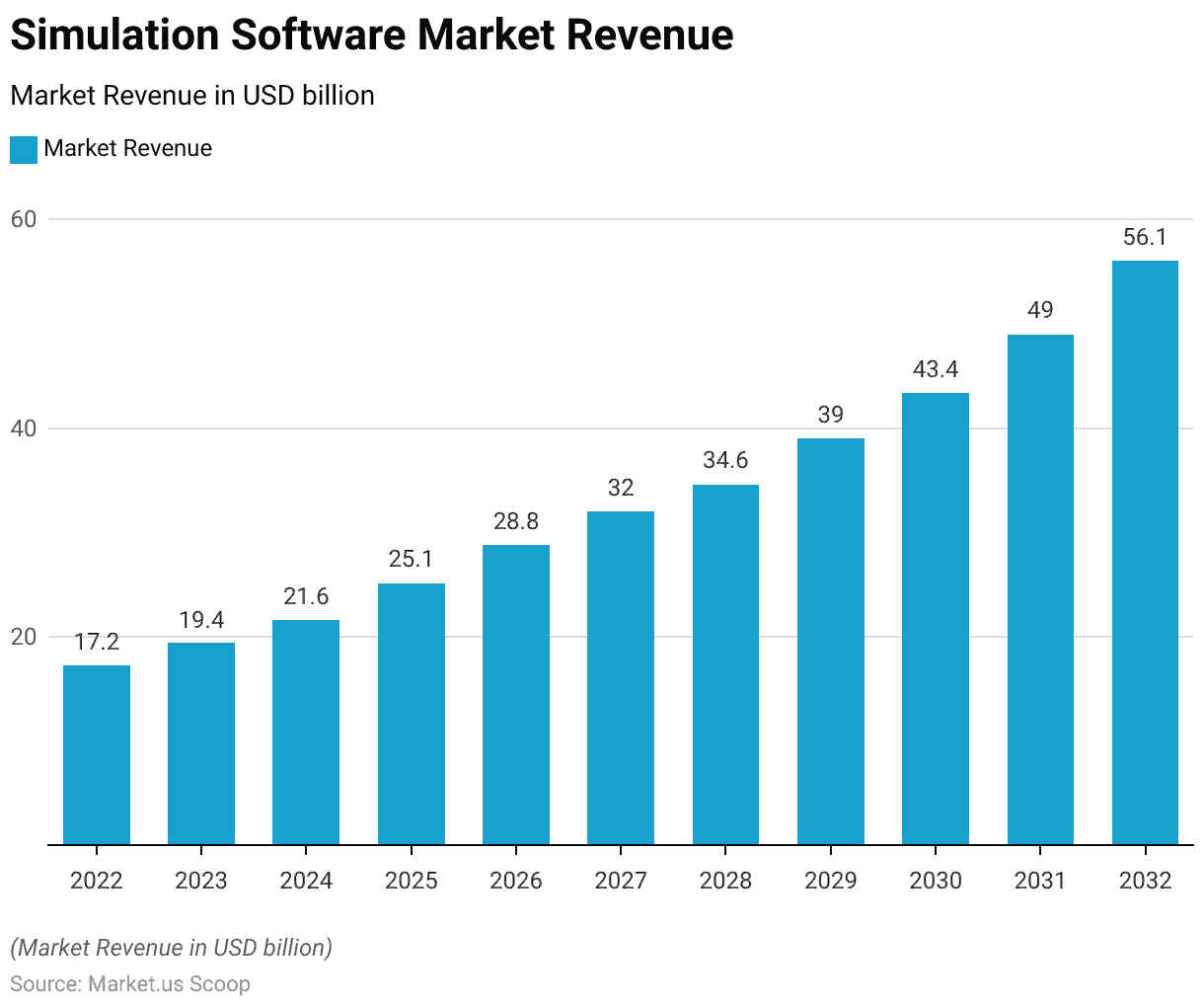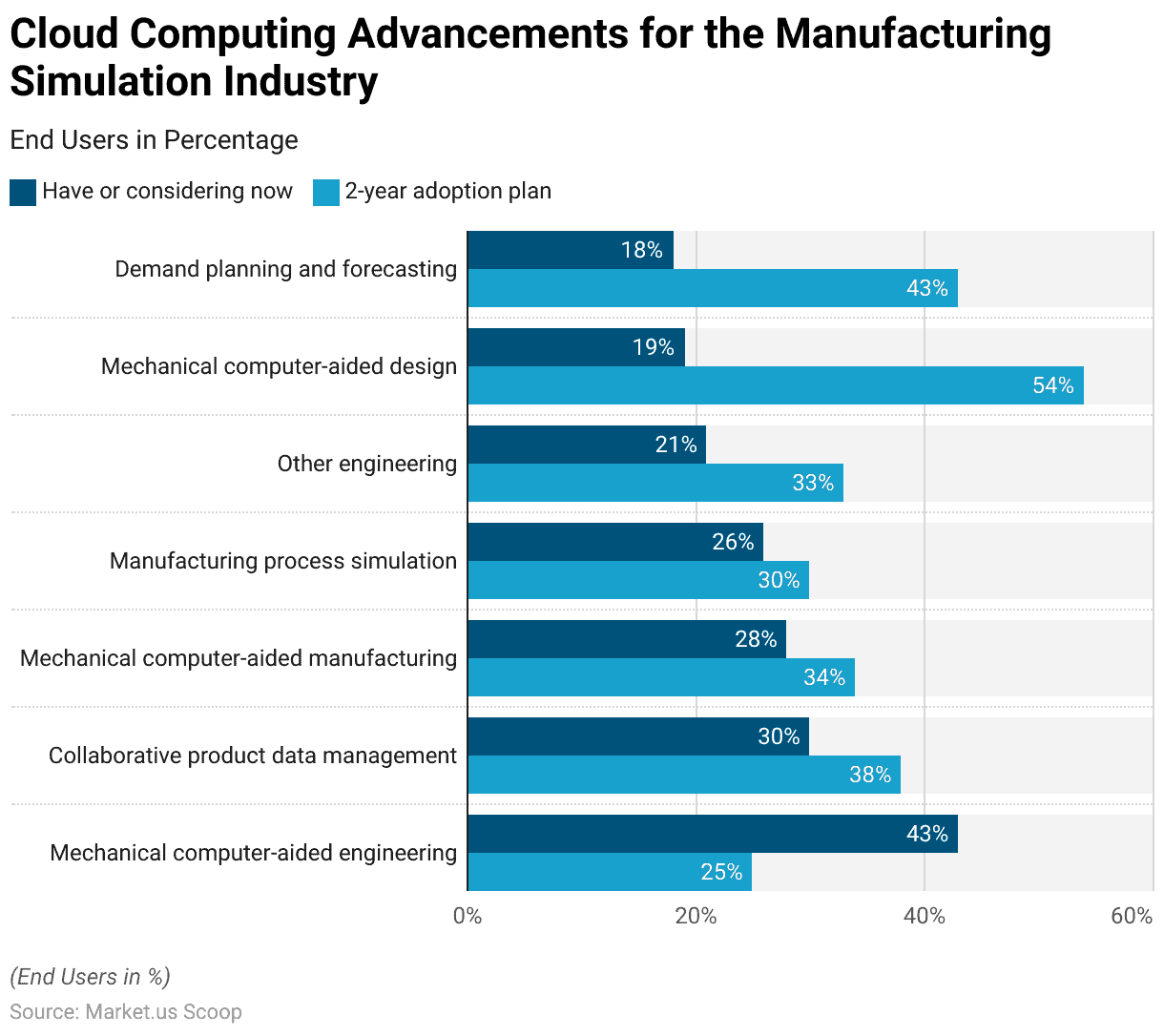Table of Contents
Introduction
According to Simulation Software Statistics, Simulation software is a versatile tool used in various industries to replicate real-world systems for analysis and decision-making. It helps reduce costs, mitigate risks, and optimize processes. There are different types of simulation software, including discrete event, continuous, agent-based, and Monte Carlo simulations, each suited for specific applications.
Users can model complex systems, run experiments, visualize data, and make informed decisions. Industries such as manufacturing, healthcare, finance, and aerospace rely on simulation software to improve efficiency and manage complex systems. Ongoing technological advancements continue to enhance its capabilities and broaden its applications.
Editor’s Choice
- The simulation software market is experiencing steady growth at a CAGR of 12.9%, as evidenced by its increasing revenue.
- In 2022, the market generated $17.2 billion in revenue and is expected to rise to 56.1 billion in 2032.
- In 2022, the total market revenue stood at USD 17.2 billion, with on-premise deployments contributing USD 12.1 billion and cloud-based solutions generating USD 5.1 billion in revenue.
- The global simulation software market is primarily dominated by software solutions, which account for a substantial 70% of the market share.
- GM Holden Australia, a branch of General Motors, experienced a 5% rise in throughput without incurring additional expenses by implementing simulation software.
- Stillwater, a mining company based in South Africa, managed to decrease their backfill time from 2-3 hours to just 20 minutes thanks to the implementation of simulation software.
- Terminal San Giorgio Ports in Italy achieved a 20% increase in its overall terminal throughput by incorporating simulation software alongside artificial intelligence.
Global Simulation Software Market Overview
Simulation Software Market Size
- The simulation software market is experiencing steady growth at a CAGR of 12.9%, as evidenced by its increasing revenue.
- In 2022, the market generated $17.2 billion in revenue, and this figure is expected to rise consistently in the coming years.
- By 2023, the revenue is projected to reach $19.4 billion, followed by $21.6 billion in 2024, and $25.1 billion in 2025.
- The growth trajectory continues with revenues of $28.8 billion in 2026, $32.0 billion in 2027, and $34.6 billion in 2028.
- The market is set to break the $39.0 billion mark in 2029, with further expansion expected in 2030 when the revenue is estimated to be $43.4 billion.
- As we look further into the future, the simulation software market is predicted to reach $49.0 billion in 2031 and a significant milestone of $56.1 billion in 2032.

Simulation Software Market Revenue- By Deployment Mode
- The global simulation software market is poised for robust growth over the coming years, as indicated by the revenue projections from 2022 to 2032.
- In 2022, the total market revenue stood at USD 17.2 billion, with on-premise deployments contributing USD 12.1 billion and cloud-based solutions generating USD 5.1 billion in revenue.
- The market is expected to witness steady expansion, with total revenue reaching USD 56.1 billion by 2032. This growth will be driven by the increasing adoption of software across various industries.
- The on-premise segment is projected to grow consistently, reaching USD 39.4 billion in 2032, while cloud-based solutions are anticipated to account for USD 16.7 billion of the market revenue in the same year.

Global Simulation Software Market Share- By Component
- The global simulation software market is primarily dominated by software solutions, which account for a substantial 70% of the market share.
- These software applications play a pivotal role in various industries, ranging from aerospace and automotive to healthcare and finance, offering simulation capabilities for diverse purposes.
- Complementing the software segment are services, constituting the remaining 30% of the market share.

Applications of Simulation Software in Various Industries
Transportation
- The transportation industry faces numerous intricacies, spanning areas like risk management, human resources, scheduling, and maintenance.
- These complexities can be mitigated or prevented through the utilization of software.
- Simulation software offers transportation companies the opportunity to enhance their resource utilization and boost overall organizational efficiency.
- For instance, GM Holden Australia, a branch of General Motors, experienced a 5% rise in throughput without incurring additional expenses by implementing simulation software.
Mining
- Simulation has transitioned from being a convenient tool to an essential technology in the mining sector. It is making significant advancements in this industry.
- For instance, Stillwater, a mining company based in South Africa, managed to decrease their backfill time from 2-3 hours to just 20 minutes thanks to the implementation of simulation software.
- Beyond operational optimization, the software also plays a crucial role in the development of more effective strategies for managing risks in mining operations.
Ports & Terminals
- When it comes to cost reduction and productivity improvement in Ports and Terminals, simulation tools prove to be the ideal choice for companies.
- For instance, Terminal San Giorgio Ports in Italy achieved a 20% increase in its overall terminal throughput by incorporating simulation software alongside artificial intelligence.
- These tools empower ports and terminals with in-depth and vital insights, enabling them to formulate plans within a risk-free environment.
- Furthermore, simulation tools are employed for risk management, internal logistics assessment, decision support, and responding to disruptions, all aimed at preventing losses.
- Through the use of simulation software, companies can efficiently manage resources for activities like yard access planning, berthing, maintenance, and logistics.
- Additionally, ports and terminals utilize simulation for container yard planning, determining stack heights, minimizing rehandling, and enhancing container throughput.
Healthcare
- Projected for 2025, the count of remote patient monitoring users may surpass 70.6 million, leading to heightened demands and scrutiny within the healthcare sector.
- Consequently, the application of simulation in healthcare proves highly beneficial for both patients and healthcare practitioners in ensuring quality care and treatment.
- An instance of this is the Nebraska Medical Center, which effectively eliminated workflow obstacles and reduced patient and physician travel time through the utilization of software.
Rail Logistics
- As of March 2023, the combined weekly rail traffic in the United States reached 458,629 carloads and intermodal units.
- This substantial traffic volume has led to a series of challenges in rail logistics, including the optimization of rail infrastructure, the enhancement of rail capacity utilization, and other related issues.
- These challenges can be effectively addressed through the application of simulation software.
- Additionally, simulation software proves valuable in tasks such as rail yard layout planning, optimizing routes, managing fleets, and efficiently planning resources in the rail industry.
Oil & Gas
- The world’s need for oil may potentially surpass 106.5 million barrels per day by 2030, and there’s also a rising demand for gas.
- Consequently, the Oil and Gas sector is poised to confront several efficiency and productivity challenges.
- To address these issues, the industry is increasingly adopting software within its operations.
- In this field, simulation software leverages industry-verified accuracy and streamlined processes to enhance safety, profitability, and overall site throughput.
Cloud Computing Advancements for the Manufacturing Simulation Industry
- As of 2018, AWS (Amazon Web Services) reported that several industrial applications were either in the process of migrating to or being contemplated for migration to the public cloud.
- These applications encompassed a wide range of functions within the industrial sector.
- Notably, 43% of respondents were actively considering or already implementing mechanical computer-aided engineering in the cloud, while 30% were in the same position for collaborative product data management.
- Mechanical computer-aided manufacturing and manufacturing process simulation followed closely, with 28% and an undisclosed percentage, respectively.
- Additionally, other engineering functions were being explored by 21% of respondents.
- Mechanical computer-aided design had 19% of respondents currently or planning to migrate in the next two years.
- Demand planning and forecasting rounded out the list, with 18% considering or actively moving these functions to the public cloud.

Discuss your needs with our analyst
Please share your requirements with more details so our analyst can check if they can solve your problem(s)



